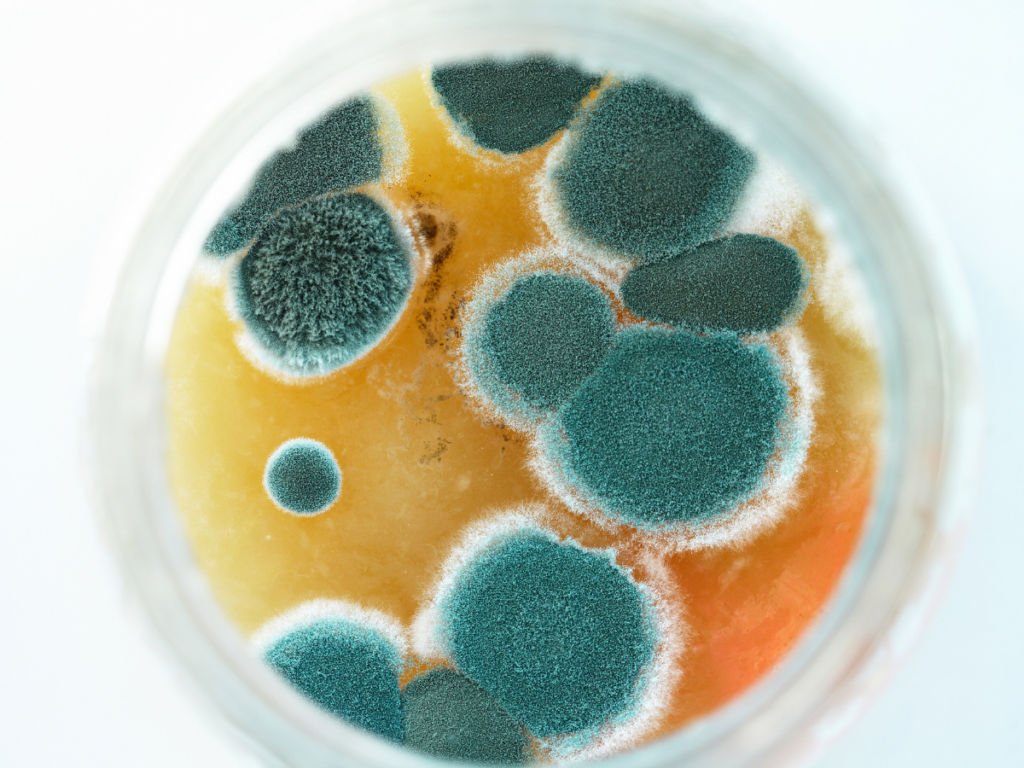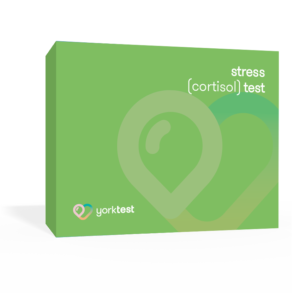Mould, which is a form of fungus, is a multicellular organism that comes in many varieties but is generally categorised as indoor or outdoor mould. Unlike fungal infections (like yeast infections, ringworm, or athlete’s foot) which are non-allergic conditions, a mould allergy occurs when the body triggers an immune system reaction to mould exposure, like inhaling airborne mould spores.
A mould allergy can manifest at any age and trigger a range of symptoms, including sneezing, coughing, runny nose, and headaches. Accurately diagnosing an allergy to mould can be difficult. Not only is it puzzling trying to figure out the source or type of mould that’s triggering the immune response, but differentiating a mould allergy from other allergens – like ragweed, pollen or dust – can be challenging too. The symptoms of a mould allergy can also range in severity from person to person. It’s common for some individuals to experience mould allergy symptoms year-round, whereas others may have flare-ups that only occur during certain times of the year.
Some mould spores spread rapidly in dry, windy conditions while other forms are more abundant in humid, moist weather, such as foggy and rainy conditions. If you suspect you have a mould allergy, it’s important to be mindful of where and when you experience symptoms, such as whether you’re indoors or outdoors, and what the environmental conditions are like. This knowledge can equip you and your GP with better awareness as to what’s triggering the allergy and how to treat it.
Testing is an effective way to determine a mould allergy. Once the source has been pinpointed, one can take measures to avoid or remove the mould to prevent future allergic reactions. Medications can also be prescribed to help alleviate mould allergy symptoms, you should always consult with a doctor or pharmacist before starting a new medication. Below we discuss in further detail the symptoms, causes, and types of mould allergies, including how to diagnose, treat, and manage the condition.
Mould Allergy Symptoms
The signs and symptoms of a mould allergy can start abruptly upon exposure or have mild symptoms that linger with prolonged exposure. Mould allergy symptoms resemble that of other types ofupper respiratory conditions and allergies. They include:
- Coughing, sneezing
- Stuffy, runny nose, or postnasal drip
- Watery, itchy eyes
- Itchy, sore throat
- Wheezing, congestion
- Dry, scaly skin
- Rash, irritated skin
Exposure to mould, even briefly, can cause a common symptom called mould rash, which is a similar skin condition seen in other forms of allergic reactions. The symptoms of mould rash include raw and sensitive skin, discoloration, itchiness, raised bumps, or dryness. Physical contact or inhalation of mould spores can trigger this rash.
When it comes to indoor mould allergy symptoms, some people can have adverse reactions that grow in severity throughout the day (especially when exposed for long periods of time). In some cases, allergy symptoms to indoor mould can gradually persist long-term, making it difficult to detect.
If you have asthma and a mould allergy, asthmatic symptoms can be triggered when exposed to mould spores. This is particularly problematic with indoor mould and cases of childhood asthma. In most cases, this can cause common symptoms like coughing, wheezing, chest tightness, and shortness of breath. In extreme cases, certain moulds can trigger a severe asthma attack.
Causes of Mould Allergy
In simple terms, moisture, oxygen, and organic materials are the key factors in facilitating mould growth both indoors and outdoors. Mould can grow on a variety of porous and non-porous materials, especially wood, leaves, foods, fabrics, plastics, and glass, as well as building materials like concrete, metal, insulation, and ceiling tiles. On the surface, mould can look green, gray, black, or other discoloration, which usually depends on the type of mould and its growing environment.
Like mushrooms, yeasts, and mildew, mould is comprised of a network of threadlike filaments that reproduce by releasing spores. These spores are small and lightweight enough to spread through the air, and they can withstand dry conditions and warm/cold temperature extremes.
One of the most common mechanisms behind a mould allergy is inhaling the spores of a particular type of mould, thereby inducing an adverse inflammatory reaction. The reaction is mediated by the body’s immunoglobulin E (IgE) protein, which rapidly triggers the activation of immune cells and the symptoms that come with it.
Beyond allergies, mould exposure is a legitimate health hazard that contributes to a range of irritation symptoms and potentially toxic substances. It’s not uncommon to be exposed to moderate amounts of mould fairly regularly, and most people are largely unaffected by limited exposure. But for some individuals, certain types of mould can trigger an immune response that causes uncomfortable symptoms. Below are common risk factors and types of mould that cause allergy symptoms.
Risk Factors of Developing Mould Allergies
There are certain risk factors that can increase the likelihood of developing a mould allergy. Or if you have a mould allergy, these factors can exacerbate your symptoms. They include:
- High humidity. Indoor humidity over 50% can increase the probability of mould growing in your home or living space. This is particularly the case in kitchens, bathrooms, basements, and below-ground rooms.
- Poor ventilation. Closed or no windows, door seals, and weak air circulation can trap moisture and enhance mould-growing conditions. In wintertime, elevated indoor concentrations of moulds can increase the risk of allergy symptoms, largely due to trapped moisture in buildings for heat retention.
- Excess moisture. Some homes and workplaces are prone to water seepage during heavy rain and floods, not to mention constant leaky pipes and condensation build-up. Any sources of excessive moisture can encourage mould growth and should be fixed when present.
- Respiratory conditions. Having a respiratory condition like COPD or asthma can be a risk factor for mould allergy and experiencing intensified symptoms.
- Family history. If allergies and asthma are common conditions that run in your family, then you may be more susceptible to developing a mould allergy.
- Occupation. Certain occupations can involve greater exposure to mould compared to others. These occupations include farming and agriculture, carpentry, logging, baking, millwork, dairy work, greenhouse work, and winemaking.
Mould can grow virtually anywhere if the conditions are right. While some situations may be difficult to deal with – like indoor mould allergies in the home or workplace – most scenarios are more predictable and avoidable.
If your home is susceptible to excess humidity or moisture, long cold seasons, or poor ventilation, it’s smart to be mindful of potential mould growth in high-humidity rooms (e.g. kitchen or bathroom), or within walls and framing, carpet and flooring, insulation, and other areas where mould might manifest.
Types of Allergenic Mould
Moulds live everywhere and can be difficult to avoid. They’re found on logs and fallen leaves outdoors and in moist places like bathrooms and kitchens indoors. Some individuals are allergic to these moulds when exposed, while others are unaffected. Below are some of the most problematic mould species to be conscious of.
Alternaria Alernata
Alternaria alternata is one of the most common types of outdoor mould that can cause hay fever or hypersensitivity reactions that are sometimes associated with asthma.
Cladosporium
A widespread indoor and outdoor mould that’s commonly found on living and dead plant material. Cladosporium is an airborne mould that easily grows on carpets, wallpaper, and window sills, as well as on potted plants and soil.
Aspergillus
A common form of indoor and outdoor mould that can cause allergic reactions, lung infections, and infections in other organs. Aspergillus is associated with allergic bronchopulmonary aspergillosis, a severe lung reaction that may cause bronchiectasis (severe widening of the bronchi in the lungs).
Penicillium
A common indoor mould allergy that’s frequently found on decaying vegetation, compost, wood, spices, dry cereals, fresh fruit, vegetables, and soil. Penicillium is most commonly associated with agricultural production, specifically fruit and vegetable spoilage.
Stachybotrys Chartarum
A highly toxic microfungus, Stachybotrys chartarum is one of the most common types of black mould that grows on cotton, wood, paper products, and other organic materials. In addition to triggering allergy symptoms in those who are allergic, Stachybotrys chartarum releases harmful mycotoxins that can cause mould poisoning in anyone with enough exposure.
Typhula Blight
Most commonly called gray snow mould or speckled snow mould, Typhula blight is a type of fungus and a turf disease that damages or kills grass after snow melts, typically in late winter. This pathogen can spread rapidly but is mostly distributed in winter climates that receive adequate snowfall.
Mould Allergy Diagnosis
Symptoms of mould allergy often mimic that of other conditions, making it difficult to diagnose. An allergist or immunologist can help you accurately diagnose a mould allergy, typically by way of a skin prick test. Alternatively, you can use a Home-To-Laboratory Allergy Testing Kit , which is a reliable way to identify mould as an allergy trigger.
Blood tests evaluate your immune system’s response to mould by measuring the amount of immunoglobulin E (IgE) antibodies in your bloodstream. Typically done at home with a simple test kit, a blood sample is sent to an accredited laboratory where it can be tested for mould allergy.
Exposure to allergenic mould can occur just about anywhere — in the home, outdoors, or at work. Assessing aspects of your home and lifestyle is important to minimize exposure and pinpoint problem areas. If you live, work, or play in a mould-prone environment, you may be able to identify the source of the mould by tracking your symptoms over a period of time, along with where you’ve been.
Treatment for Mould Allergy
Prevention, management, and treatment of mould allergies are the most important measures to take in minimizing unpleasant symptoms. If you’re planning to be around potential sources of mould, such as being outdoors, taking antihistamines, decongestants, and allergy medications in advance can help relieve symptoms. You can also wear a facemask to prevent inhaling mould spores.
While avoiding exposure to allergy triggers is the best way to eliminate symptoms, unfortunately, moulds are ever-common and it can be difficult to completely avoid them. Although there’s no guaranteed cure for allergic rhinitis caused by a mould allergy, there are a number of treatments and medications that can relieve symptoms, including:
- Antihistamines. A popular medication that can help reduce allergy symptoms, like itching, sneezing, and runny nose. With over-the-counter options available, antihistamines work by blocking the inflammatory chemical (histamine) released by the immune system during an allergic reaction.
- Nasal corticosteroids and sprays. Decongestant nasal sprays help treat and prevent upper respiratory inflammation caused by mould allergies. Often one of the first medications prescribed, corticosteroids and nasals are effective but shouldn’t use long-term.
- Oral decongestants. This treatment can help dampen the cold-like allergy symptoms that can result from mould exposure, like congestion, sore throat, and postnasal drip.
- Immunotherapy. Also commonly known as allergy shots, this is a form of treatment that an allergist can prescribe and is shown to be effective in providing long-term relief.
To keep allergy symptoms at bay, there are certain lifestyle and home remedies that can help. Dust masks, avoiding the outdoors at certain times, regulating indoor humidity levels, and sleeping with the windows closed are just a few ideas. Managing an allergy requires understanding your unique triggers and how to avoid them.
Indoor Mould Allergy Management & Prevention
In addition to treating symptoms, the other key component in controlling your mould allergies is to guard against mould growth and exposure in and around your home:
- Avoid using carpet, rugs, and moisture-absorbing materials in bathrooms and basements
- Be sure all bathrooms are properly ventilated and use the ventilation fan during showers or baths to minimize moisture accumulation.
- Use a dehumidifier, especially in areas that are humid, damp, and musty. Keep your humidity levels below 50-60 percent whenever possible.
- Take measures to prevent sources of dampness in basements, specifically with groundwater runoff and pipe leaks
- Promote groundwater drainage away from your house and ensure the ground slopes away from the foundation.
- Remove leaves and vegetation from around the foundation and clean out rain gutters frequently
- Keep plants and their containers clean and dry, especially those made of organic materials like stone, wicker, or hemp.
- Use a high-efficiency particulate air (HEPA) filter with air conditioners, furnaces, or other ventilation systems, and change filters regularly.
If you’re struggling with persistent mould in your home you should contact your landlord, if renting, or consult with a mould removal specialist if you’re a home owner. This is important to address the underlying issues which could cause structural damage to the house, as well as posing a risk to your health.
Always seek advice from your GP or an allergist if you’re experiencing severe symptoms associated with a mould allergy. However, a home-to-laboratory blood test is a convenient and affordable option if you experience milder symptoms you believe could be linked to mould. The YorkTest Food & Environmental Allergy Test measures your IgE reaction to 23 common food allergens, plus 19 environmental allergens – including Cladosporium mould.











